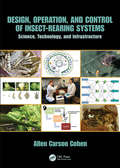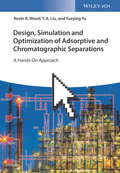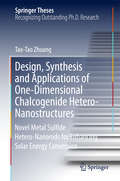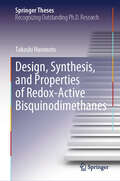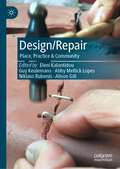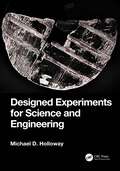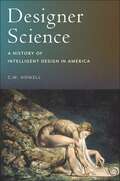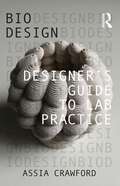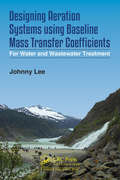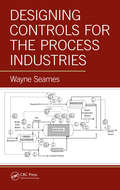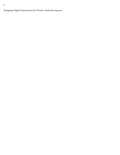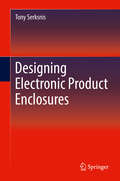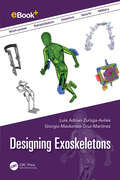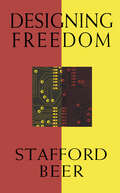- Table View
- List View
Design, Operation, and Control of Insect-Rearing Systems: Science, Technology, and Infrastructure
by Allen Carson CohenDesign, Operation, and Control of Insect-Rearing Systems: Science, Technology, and Infrastructure explains the fundamental components of insect rearing: 1) the rearing systems, per se 2) personnel 3) education of rearing personnel 4) communication of procedures 5) an in-depth look at silkworm rearing 5) facilities where rearing is conducted, and 6) funding for all these components. Insect rearing serves a wide array of purposes, including research, pest control by sterile insect technique and biological control, production of insects as food for other animals, conservation, education, and even far-reaching technology where insects are used to produce products such as pharmaceutical materials and strong, multipurpose textiles. This book surveys and analyzes insect rearing from a scientific and technology-based approach. At its foundation, this approach assumes that rearing systems are complex interactions of components that can be understood and controlled by using a mechanistic approach. Author Allen Carson Cohen explains the infrastructure of rearing systems, their current status and character, and what kind of changes can be made to improve the field of insect rearing. Two Appendices republish out-of-print monographs that provide fascinating historical context to the development of the insect-rearing systems we have today.
Design, Simulation and Optimization of Adsorptive and Chromatographic Separations: A Hands-On Approach
by Y. A. Liu Kevin R. Wood Yueying YuThis book allows the reader to effectively design, simulate and optimize adsorptive and chromatographic separations for industrial applications. To achieve this, a unified approach is presented, which develops the ideal and intermediate equations necessary, while simultaneously offering hands-on case studies employing the rigorous simulation packages Aspen Adsorption and Aspen Chromatography. The first part of the book deals with design strategies, detailed design considerations and the assumptions, which the models are allowed to make and covers shortcut design methods as well as mathematical tools to determine optimal operating conditions. These insights are used in Chapter 4 & 5 to estimate and optimize performance parameters, such as purity, recovery, etc. as well as the regression of these parameters.
Design, Synthesis and Applications of One-Dimensional Chalcogenide Hetero-Nanostructures
by Tao-Tao ZhuangThis thesis focuses on the design and synthesis of novel one-dimensional colloidal chalcogenide hetero-nanostructures for enhancing solar energy conversion applications. Semiconducting nanomaterials are particular attractive for energy conversion due to the quantum confinement effects dictating their unique optical and electronic properties. Steering the photo-induced charge-flow based on unique bandgap alignment in semiconductor heterojunctions is critical for photo-electric/chemical conversion.The author presents the controllable preparation strategies to synthesize 1D chalcogenide hetero-nanostructures with various fine structures, further been used as excellent template materials for preparing other novel and complex hybrid architectures through a series of chemical transformations. The heterogeneous growth mechanisms of novel hetero-nanostructures is studied for developing a facile and general method to prepare more novel heterostructures. The band gap structure simulations, detailed charge carrier behaviour and unique solar energy conversion properties of the prepared hybrid nanostructures are deeply investigated. This work would open a new door to rationally designing hybrid systems for photo-induced applications.
Design, Synthesis and Characterization of new Supramolecular Architectures
by Massimo BaronciniThis thesis focuses on the bottom-up design, construction and operation of supramolecular systems capable of behaving as devices and machines on the molecular scale, which is a topic of great interest in nanoscience and a fascinating challenge in nanotechnology. In particular, the systems investigated here include: polyviologen dendrimers capable of behaving as hosts and chargestoring devices; molecular machines based on pseudorotaxanes/rotaxanes and operated by photoinduced proton transfer, or photoisomerization reactions; and a simple unimolecular multiplexer/demultiplexer. The systems have been characterized using a variety of techniques including absorption and emission spectra, laser flash photolysis, NMR spectroscopy, electrochemical experiments, stopped flow measurements. This research addresses a large number of open problems in the nanosciences, dealing with a wide range of the most advanced applications of supramolecular systems.
Design, Synthesis, and Properties of Redox-Active Bisquinodimethanes (Springer Theses)
by Takashi HarimotoThis book focuses on the construction of redox systems composed of doubly fused para-quinodimethane (p-QD) units and on the elucidation of the unique redox behavior. p-QD is a class of non-aromatic π-conjugated compounds that is well-known to be interconvertible scaffolds in many response systems due to its contribution of resonance structure with a planar aromatic sextet ring. This book describes studies on a strategy for precisely controlling the frontier orbital levels of p-QD-based redox systems and a nature of cationic states of π-electron systems with doubly fused p-QD units. The author revealed that multi-redox unimolecular systems with cross-linking of the two sterically strained p-QD units exhibit unique hysteretic character or have a domino effect upon electron transfer, which cannot be achieved in a monomeric p-QD-based system. Thus, these studies are milestones in creating functional redox systems unprecedented dynamic redox (dyrex) behaviors. A study on cationic states of π-electron systems with doubly fused p-QD units and their intrinsic redox properties will lead to the development of unprecedented dyrex systems, the frontier orbital levels of which can be precisely controlled by input of external stimuli such as electric potential and heat. This book benefits chemists with a deeper understanding of the redox-active molecules.
Design/Repair: Place, Practice & Community
by Alison Gill Eleni Kalantidou Guy Keulemans Abby Mellick Lopes Niklavs RubenisThis collection of essays sheds light on repair as a disposition to material culture and a practice rooted in diverse sociocultural experiences. It provides an in-depth exploration of how repair manifests itself through the different lenses of governance, grassroots activism, transformative design and community-led initiatives. Most importantly, the chapters demonstrate how place-based approaches can reveal blueprints for social impact in circumstances of growing environmental and social precariousness.
Designed Experiments for Science and Engineering
by Michael D. HollowayDesigned Experiments for Science and Engineering is a versatile and overarching toolkit that explores various methods of designing experiments for over 20 disciplines in science and engineering.Designed experiments provide a structured approach to hypothesis testing, data analysis, and decision‑making. They allow researchers and engineers to efficiently explore multiple factors, interactions, and their impact on outcomes, ultimately leading to better‑designed processes, products, and systems across a wide range of scientific and engineering disciplines. Each discipline covered in this book includes the key characteristics of the steps in choosing and executing the experimental designs (one factor, fractional factorial, mixture experimentation, factor central composite, 3‑factor + central composite, etc.) and reviews the various statistical tools used as well as the steps in how to utilize each (standard deviation analysis, analysis of variance [ANOVA], relative standard deviation, bias analysis, etc.).This book is essential reading for students and professionals who are involved in research and development within various fields in science and engineering, such as mechanical engineering, environmental science, manufacturing, and aerospace engineering.
Designer Animals
by Conrad Brunk Sarah HartleyDesigner Animals is an in-depth study of the debates surrounding the development of animal biotechnology, which is quickly emerging out of the laboratory and into the commercial marketplace. This book innovatively combines expert analysis on the technology's economic, professional, ethical, and religious implications while remaining firmly grounded in the 'real world' political environment in which the issue is played out. Designer Animals uses non-technical language to explore the science behind animal biotechnology and the ethical frameworks at play in its surrounding debates. By investigating the interests of major stakeholders, including researchers on the cutting edge of science; mainstream and 'alternative' agriculture organizations; the animal welfare movement; and health care providers, patients, and researchers, the contributors illuminate the most important points of agreement and disagreement on this hotly contested topic.
Designer Science: A History of Intelligent Design in America
by C.W. HowellThe history of the intelligent design movement and its legacyAnti-science rhetoric in contemporary American politics has become a preoccupying concern for science educators, politicians, and government employees. But why are so many Americans primed to distrust the scientific establishment? This book offers a history of the intelligent design movement, analyzing the links between the legal contests over United States high school curricula and a radical rejection of contemporary scientific practice. Though closely associated with creationism, the intelligent design movement has its own story. It is related to but different from the various forms of creationism, and it has a unique background in natural theology and conservative politics. Typically perceived today as defunct after its public defeat in the 2005 Kitzmiller v. Dover court case, intelligent design did not disappear, and this book makes the case that its legacy is far more significant than we might think. Though it failed to achieve its goal of remaking contemporary science, intelligent design played a crucial role in legitimizing a mindset of suspicion which has taken hold in discussions of climate change, COVID-19, and vaccine hesitancy. In today’s post-truth moment, where scientific expertise has become increasingly rejected, the volume showcases that the intelligent design movement’s most lasting effects may not be in its challenge to evolution, but in the way it influenced the public’s understanding of science and scientists. Designer Science makes the case that we are all grappling today with intelligent design’s legacy, and it offers a history of how we got here.
Designer’s Guide to Lab Practice (Bio Design)
by Assia CrawfordThis book explores the growing field of bio-design through interdisciplinary creative practice. The volume illustrates a range of experimental working techniques while offering a foundational understanding of lab practice principles. The book highlights the myriad of opportunities presented by microorganisms that have reshaped the planet and made it habitable. The book provides an account of the creation of living materials from the point of view of an architectural design practitioner. The transition from traditional design practice to laboratory investigation is captured, highlighting strategies of creating partnerships across a range of fields. The book demonstrates laboratory methods and ways of investigating the development of living materials and celebrates the growing body of practitioners, scientists, activists and anthropologists who are reimagining new strategies for addressing contemporary environmental challenges. Designer's Guide to Lab Practice looks at ways in which integrating living components with needs of their own would not only help offset the environmental impact that we have on our planet but could also create a closer relationship with nature. It is a working manual as well as a guide to emerging practitioners seeking to transition into a field that is yet to be defined and that offers the promise of a new era of human habitat making as a direct response to the looming ecological crisis.
Designing Aeration Systems using Baseline Mass Transfer Coefficients: For Water and Wastewater Treatment
by Johnny LeeThe book is about the discovery of a Standard Specific Baseline Mass Transfer Coefficient (KLa0)20 that represents a revolutionary change in the understanding, designing, and operation of aeration equipment, as well as providing a baseline for future research and development for water and wastewater treatment systems. It discusses the use of the Standard Model for oxygen transfer to determine the baseline, and its major finding is to show that the gas transfer model is a consistent relativistic theory of molecular interactions. Previously, the challenge was the appearance of divergences in the mass transfer coefficient estimations that defies aeration design. This normalization to a baseline is a great achievement in physics and engineering.
Designing Bioactive Polymeric Materials For Restorative Dentistry
by Mary Anne S. MeloRestorative biomaterials in dentistry are designed to restore the shape and function of teeth. Their applicability is related to restorative procedures such as dental restorations, dentures, dental implants, and endodontic materials. Designing Bioactive Polymeric Materials for Restorative Dentistry reviews the current state of the art for restorative biomaterials and discusses the near-future trends in this field. The book examines the biomaterials utilized in restorative dental applications (bonding, composites, cements, and ceramics) and assesses the design for these materials and the role of nanotechnology. All of the contributors are active clinical dentists and researchers in this field. FEATURES Overviews the major ongoing research efforts on developing bioactive bonding systems and composites in dental biomaterials Focuses on emerging trends in restorative dental biomaterials Incorporates evidence-based data on new restorative dental materials throughout the book Features extensive references at the end of each chapter to enhance further study Mary Anne S. Melo, DDS, MSc, PhD FADM, is an Associate Professor and Division Director of Operative Dentistry at the School of Dentistry, University of Maryland, Baltimore, Maryland.
Designing Controls for the Process Industries
by Wayne Seames<p>Offering a modern, process-oriented approach emphasizing process control scheme development instead of extended coverage of LaPlace space descriptions of process dynamics, this text focuses on aspects that are most important for process engineering in the 21st century. Instead of starting with the controller, the book starts with the process and moves on to how basic regulatory control schemes can be designed to achieve the process’ objectives while maintaining stable operations. In addition to continuous control concepts, process and control system dynamics are embedded into the text with each new concept presented. <p>The book also includes sections on batch and semi-batch processes and safety automation within each concept area. It discusses the four most common process control loops—feedback, feedforward, ratio, and cascade—and discusses application of these techniques for process control schemes for the most common types of unit operations. It also discusses more advanced and less commonly used regulatory control options such as override, allocation, and split range controllers, includes an introduction to higher level automation functions, and provides guidance for ways to increase the overall safety, stability, and efficiency for many process applications. It introduces the theory behind the most common types of controllers used in the process industries and also provides various additional plant automation-related subjects.</p>
Designing Controls for the Process Industries
by Wayne SeamesOffering a modern, process-oriented approach emphasizing process control scheme development instead of extended coverage of LaPlace space descriptions of process dynamics, Designing Controls for the Process Industries focuses on aspects that are most important for contemporary practical process engineering and reflects the industry’s use of digital distributed control-based systems. The second edition now features 60 tutorial videos demonstrating solutions to most of the example problems. Instead of starting with the controller, the book starts with the process and moves on to how basic regulatory control schemes can be designed to achieve the process objectives while maintaining stable operations. In addition to continuous control concepts, process and control system dynamics are embedded into the text with each new concept presented. The book alsoincludes sections on batch and semi-batch processes and safety automation within each concept area. It discusses the four most common control techniques: control loop feedback, feedforward, ratio, and cascade, and discusses application of these techniques for process control schemes for the most common types of unit operations. It also discusses more advanced andless commonly used regulatory control options such as override, allocation, and split range controllers; includes an introduction to higher-level automation functions; and provides guidance for ways to increase the overall safety, stability, and efficiency for many process applications. It introduces the theory behind the most common types of controllers used in the process industries and provides various additional plant automation-related subjects. The new edition also includes new homework problems and examples, including multiple choice questions for flipped classes, information about statistical process control, and a new case study that documents the development of regulatory control schemes for an entire process area. Aimed at chemical engineering students in process control courses, as well as practicing process and control engineers, this textbook offers an alternative to traditional texts and offers a practical, hands-on approach to design of process controls. PowerPoint lecture slides, multiple-choice quiz questions for each chapter, and a solutions manual are available to qualifying instructors. Tutorial-style videos for most of the text examples are available for all readers to download.
Designing Dendrimers
by Sebastiano Campagna Fausto Puntoriero Paola CeroniResearch on dendrimers has exploded in the last 15 years, moving from the establishment of synthetic methodologies, particularly in the early years up to the end of nineties, towards sophisticated and wide-ranging applications. Dendrimers play an important role in many different areas, spanning from basic synthetic approaches to artificial photosynthesis, to medicine, to catalysis. The great potential of dendrimers is well-recognized by the hundreds of papers in the field and the increasing number of patents, and stimulated developments in other areas of knowledge, including new characterization techniques. However, some basic principles and methods still continue to give a unity to the field. Although several books on dendrimers have been published during these 15 years, the very recent progresses in new areas now requires a new point of view, trying to give a unifying and comprehensive outlook of the field. Since the first dendrimer was synthesized by Vögtle in 1978, dendrimers have experienced an explosion of scientific interest because of their unique molecular architecture. This resulted in over 5,000 scientific papers and patents published by the end of 2005. The proposed book will cover both fundamental and applicative aspects of dendrimer research. Chapters devoted to basic principles, synthetic methods and strategies, and advanced characterization techniques will be integrated by chapters illustrating the full potential of dendrimers in various fields, like artificial photosynthesis, multi-redox pool systems, diagnostics, biomedical and sensing purposes, design of functional nanostructures. Particular emphasis will be devoted to possible future developments.
Designing Digital Experiences For Positive Youth Development: From Playpen To Playground
by Marina Umaschi BersBased on over a decade and a half of research, Designing Digital Experiences for Positive Youth Development aims to guide readers in the design of digital technologies to promote positive behaviors in children and teenagers.
Designing Electronic Product Enclosures
by Tony SerksnisThis text explains the process of the design of product electronic enclosures. These products typically contain a printed circuit board. The text takes the reader from the original idea for a product, through the shipment in quantity to a customer. For the product enclosure designer, this proceeds through design layout, material selection, prototype building, testing, and ongoing design improvement. The book presents a substantive and lucid treatment of the structural, thermal, user-interface, assembly, quality control, and cost considerations of the product enclosure. Of special note is a discussion on the regulatory issues involved with the design of a product. A main thrust of the text is on the "commercialization" aspects of electronic products, that is, when an enclosure is needed for the product to meet environmental and certification requirements globally. The book targets the broadest audience tasked to design/manufacture an enclosure, from mechanical/industrial engineers to designers and technicians. While the intent of the text is not to provide a complete understanding of relevant physical phenomena addressed (strength of materials, shock and vibration, heat transfer), the book provides a ready reference on how and where these key properties may be considered in the design of most electronic enclosures.Elucidates successful enclosure design for electronic products, defining the design team and the definition of successExplains the processes for building enclosures, including printed circuit board layout (mechanical considerations) and optimal object placement, structural considerations, material selection, and user interface designIncludes treatment of serviceability, product environments, standards and testing, cooling techniques as well as guidelines for Electromagnetic Compliance (EMC) standards and testing required to pass FCC/CEReinforces design concepts presented with relevant solved problems
Designing Engineering Structures using Stochastic Optimization Methods
by Levent Aydin H Seçil Artem Selda OterkusAmong all aspects of engineering, design is the most important step in developing a new product. A systematic approach to managing design issues can only be accomplished by applying mathematical optimization methods. Furthermore, due to the practical issues in engineering problems, there are limitations in using traditional methods. As such, stochastic optimization methods such as differential evolution, simulated annealing, and genetic algorithms are preferable in finding solutions in design optimization problems. This book reviews mechanical engineering design optimization using stochastic methods. It introduces students and design engineers to practical aspects of complicated mathematical optimization procedures, and outlines steps for wide range of selected engineering design problems. It shows how engineering structures are systematically designed. Many new engineering design applications based on stochastic optimization techniques in automotive, energy, military, naval, manufacturing process and fluids-heat transfer, are described in the book. For each design optimization problem described, background is provided for understanding the solutions. There are very few books on optimization that include engineering applications. They cover limited applications, and that too of well-known design problems of advanced and niche nature. Common problems are hardly addressed. Thus, the subject has remained fairly theoretical. To overcome this, each chapter in this book is contributed by at least one academic and one industrial expert researcher.
Designing Exoskeletons
by Luis Adrian Zuñiga-Aviles Giorgio Mackenzie Cruz-MartinezDesigning Exoskeletons focuses on developing exoskeletons, following the lifecycle of an exoskeleton from design to manufacture. It demonstrates how modern technologies can be used at every stage of the process, such as design methodologies, CAD/CAE/CAM software, rapid prototyping, test benches, materials, heat and surface treatments, and manufacturing processes. Several case studies are presented to provide detailed considerations on developing specific topics. Exoskeletons are designed to provide work-power, rehabilitation, and assistive training to sports and military applications. Beginning with a review of the history of exoskeletons from ancient to modern times, the book builds on this by mapping out recent innovations and state-of-the-art technologies that utilize advanced exoskeleton design. Presenting a comprehensive guide to computer design tools used by bioengineers, the book demonstrates the capabilities of modern software at all stages of the process, looking at computer-aided design, manufacturing, and engineering. It also details the materials used to create exoskeletons, notably steels, engineering polymers, composites, and emerging materials. Manufacturing processes, both conventional and unconventional are discussed—for example, casting, powder metallurgy, additive manufacturing, and heat and surface treatments. This book is essential reading for those in the field of exoskeletons, such as designers, workers in research and development, engineering and design students, and those interested in robotics applied to medical devices.
Designing Freedom (The CBC Massey Lectures)
by Stafford BeerDistinguished cyberneticist Stafford Beer states the case for a new science of systems theory and cybernetics. His essays examine such issues as The Real Threat to All We Hold Most Dear, The Discarded Tools of Modern Man, A Liberty Machine in Prototype, Science in the Service of Man, The Future That Can Be Demanded Now, The Free Man in a Cybernetic World. Designing Freedom ponders the possibilities of liberty in a cybernetic world.
Designing Futures: Bridging Creativity, Sustainability, and Technology in Education and Industry (Advances in Science, Technology & Innovation)
by Angeles Sánchez Marina Checa Olivas Saimir Shtylla Antonio Maffei Claudio SassanelliThis book is a compelling exploration into the integration of sustainability with creativity and technology. It offers a cohesive journey from theoretical insights into practical applications across creative disciplines, education, and industries. This book serves as a crucial guide for those looking to navigate the challenges of modern sustainability through innovative solutions. By showcasing examples from 3D printing in education to sustainable practices in creative industries and the preservation of cultural heritage through digital innovation, it highlights the transformative power of creativity in fostering a sustainable future. Aimed at academics, professionals, and students, this book is an invitation to engage, innovate, and contribute to the sustainability discourse in the creative sectors.
Designing Gluten Free Bakery and Pasta Products
by Marina F. de Escalada Pla Carolina E. GenevoisThe ingestion of gluten in the human diet can lead to gastrointestinal disorders such as celiac disease, allergy to wheat and non-celiac gluten sensitivity. Currently the best treatment is the strict adherence to a diet without sources of prolamins and gliadins (wheat), secalin (rye) and hordein (barley). Several studies have revealed that a gluten-free diet may lead to nutrient deficiencies. Therefore, the formulation of gluten-free foods, particularly those related to cereals, is a major challenge. A great effort has been put into improved technological and nutritional aspects of gluten-free cereal products, as evidenced by the large amount of research published in journal articles. Thus far there has been no compilation of this up-to-date research which would lead to better implementation of healthy gluten-free products with improved technological and sensorial properties. Designing Gluten Free Bakery and Pasta Products provides a tool for designing gluten-free bakery and pasta products taking into account the most up-to-date advances and knowledge of gluten-related disorders , extensively covering both traditional and non-traditional gluten-free raw materials and bakery and pasta processes. This book will be particularly useful for food scientists and technologists developing gluten-free bakery and pasta products, plus physicians and nutritionists working with patients with gluten related diseases. This book covers new native/seasonal ingredients that improve the nutritional profile of baked goods, shelf life and starch retrogradation during storage, gluten-free edible film/toppings application, biotechnological pre-treatments of gluten-free flours and ingredients to enhance their technological/nutritional functionality, baked goods with spontaneous fermentation, sourdough from yeasts vs LAB present in gluten-free flours and effects on technological, nutritional and sensory characteristics. All these aspects were extensively discussed in this work, plus it provides a fully up-to-date studies on gluten-related health disorders and summarizes the main research advances in gluten-free product development and their market-related and industrial impact. This novel approach makes this book a unique and highly valuable resource for those on the forefront of gluten-free foods application.
Designing Healthy Buildings and Communities: Shaping a Climate-Resilient Future (Urban Sustainability)
by Jian Zuo Ali Cheshmehzangi Ayyoob Sharifi Rongpeng Zhang Abbas Ziafati Bafarasat Jie ZhaoThis book aims to explore and showcase global case studies focused on creating buildings and communities that promote health while enhancing climate resilience. In an era where climate change increasingly impacts urban environments, there is a critical need for innovative solutions that go beyond conventional practices. This book compiles a diverse range of examples, drawing on real-life projects and potential paradigm shifts that emphasise novel ideas and advanced methodologies. The featured case studies span various aspects of building and community design, including architectural design directions, technology integration, and technical methods. Each contribution provides practical examples that illustrate the implementation of these concepts in real-world settings. By highlighting innovative approaches, the book challenges the status quo and encourages a shift from business-as-usual scenarios to forward-thinking strategies that prioritise both human health and environmental sustainability. Key themes include the integration of green building technologies, the adoption of sustainable materials, and the incorporation of nature-based solutions in community design. Additionally, the book delves into community-driven initiatives that foster social cohesion and climate-resilience, demonstrating how collaborative efforts can lead to more robust and adaptable cities. Through detailed analyses and comprehensive discussions, this book serves as a vital resource for architects, urban planners, policymakers, and researchers. It provides insights into cutting-edge practices and offers inspiration for future projects aimed at creating a healthier and more sustainable future. By bringing together these global perspectives, the book highlights the importance of innovation and adaptability in the face of climate challenges, ultimately contributing to the development of sustainable and thriving urban landscapes.
Designing Healthy Cities: Integrating Climate-Resilient Urbanism for Sustainable Living (Urban Sustainability)
by Jian Zuo Ali Cheshmehzangi Ayyoob Sharifi Rongpeng Zhang Abbas Ziafati Bafarasat Jie ZhaoThis book investigates how urban planning can promote inclusive, climate-resilient, and healthy communities. With cities worldwide battling the twin problems of increasing urbanization and the intensifying effects of climate change, this book offers a relevant, multidisciplinary framework for rethinking urban areas to support equity, well-being, and environmental sustainability. The book explores the connections between environmental resilience, urban planning, and public health, grounded in state-of-the-art research and enhanced by real-world case studies. It emphasizes how urgent it is for cities to adopt proactive, forward-thinking design strategies in order to both adapt to and lessen the effects of climate change. The book offers practical advice for designing areas that are useful and improve city dwellers' physical and emotional health by fusing sustainable urbanism with human-centered methodologies. The book emphasizes the necessity of adopting comprehensive, integrated approaches to urban development from a forward-looking standpoint. It urges people to change their perspective from seeing cities only as centers of economic activity to seeing them as living ecosystems that support and care for their residents. By doing this, the book hopes to motivate a new generation of urban leaders and thinkers who are committed to creating cities that coexist peacefully with the environment. It also gives the readers the essential knowledge and resources to help create a sustainable and resilient urban future, whether they are practitioners influencing urban policy or citizens who are enthusiastic about fostering healthier living conditions.
Designing Human Practices: An Experiment with Synthetic Biology
by Paul Rabinow Gaymon BennettIn 2006 anthropologists Paul Rabinow and Gaymon Bennett set out to rethink the role that human sciences play in biological research, creating the Human Practices division of the Synthetic Biology Engineering Research Center—a facility established to create design standards for the engineering of new enzymes, genetic circuits, cells, and other biological entities—to formulate a new approach to the ethical, security, and philosophical considerations of controversial biological work. They sought not simply to act as watchdogs but to integrate the biosciences with their own discipline in a more fundamentally interdependent way, inventing a new, dynamic, and experimental anthropology that they could bring to bear on the center’s biological research. Designing Human Practices is a detailed account of this anthropological experiment and, ultimately, its rejection. It provides new insights into the possibilities and limitations of collaboration, and diagnoses the micro-politics which effectively constrained the potential for mutual scientific flourishing. Synthesizing multiple disciplines, including biology, genetics, anthropology, and philosophy, alongside a thorough examination of funding entities such as the National Science Foundation, Designing Human Practices pushes the social study of science into new and provocative territory, utilizing a real-world experience as a springboard for timely reflections on how the human and life sciences can and should transform each other.
